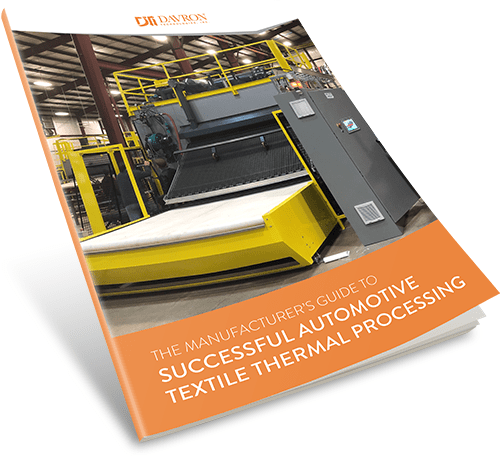If the perfect machine exists in automotive manufacturing facilities, it’s one that works as designed from the moment it’s switched on and then never breaks down.
In the crowded, competitive world of Tier 1, 2 and 3 automotive suppliers, profitability depends on coming as close to perfection as technology permits.
But equipment is only part of the equation.

The perfect machine wouldn’t amount to much if it wasn’t in the care of the right team of people from day one. Unfortunately, involving the operation team on automotive textile oven integration is most often overlooked by manufacturers.
Getting it right might mean rethinking the way operators and maintenance personnel are trained. We have some ideas.
Clarity and diligence in design development
When you boil it down, thermal process equipment for automotive textile manufacturing takes shape when these basic questions are answered:
- What type of product does our customer need?
- What target production rate must we meet?
- What space constraints will we confront in our facility?
- What is our customer’s target schedule?
- How much will a system cost, and how soon can we get it?
For many automotive suppliers, it stops there. They engage an equipment vendor and collaborate on design development solely focused on the quantitative benchmarks a machine must meet. This comes at the expense of thinking through operator interface or ease of maintenance—decidedly qualitative aspects that nonetheless make tangible impacts on production.
For example, when operators or engineers realize they don’t like a system’s HMI user experience after installation, it is likely too late. Either they tolerate a situation that’s not ideal, expend to fix it themselves or pay the vendor to come back out to make a change. None is an attractive option.
We advise engineers to think through both the “what” and the “how,” and be clear about those expectations before system design is finalized. Eliminating late-stage change orders preserves the cost certainty that automotive suppliers need to thrive.

People are essential, especially in the automation era
Even though production systems are increasingly automated, human interaction remains essential to their operation.
In fact, skilled operators and knowledgeable maintenance teams are essential because of how sophisticated production equipment has become.
Taking the time to adequately train operators and maintenance teams—and even involving them in factory acceptance testing—is essential to successful equipment integration.
Bringing the heat
The manufacturer’s guide to successful automotive textile thermal processing

In-depth operator training is good risk management
When equipment is installed, automotive suppliers usually only accommodate for one or two key people to receive training. Knowledge filters down to the day-to-day labor force from there.
We’ve also observed training that occurs simultaneously with system assembly and factory acceptance testing.
It’s obviously faster and cheaper to take a minimal approach. We know that manufacturers are under pressure to keep costs in check and avoid prolonged down time. But this creates longer-term risks that outweigh the rewards of jumpstarting production.
For one thing, key information might be lost in translation when equipment suppliers “train the trainers” instead of training operators directly. For another, abbreviated training that coincides with installation and testing does not represent actual production conditions and can confuse operators and maintenance personnel.
Involving these individuals during design development acclimates them to new equipment sooner and ultimately shortens their learning curve.
It’s also worth noting that frequent operator turnover is common in the industry. Consider including more senior staff in training to ensure there’s always someone on hand who knows how a system works.
We believe training operators directly is ideal, and it’s even better if training can occur separately from installation. Manufacturers get better long-term results with new heating systems when they create space for operators to learn from—and question—the team that built the system in the first place.
This risk is amplified for lower-volume, higher-variety manufacturers whose equipment must accommodate a dozen or more recipes instead of just two or three. Every changeover becomes a potential failure mode for operators not adequately trained.
Too often, process engineers call equipment providers with the complaint that production has stopped because a machine doesn’t work. Nine times out of ten, the machine is not the problem.
Empowered maintenance teams solve more problems and keep production going
Effective integration of new heating equipment is directly tied to how well maintenance teams are prepared to complete preventative maintenance or repairs.
These key people are often simply handed manuals and wiring diagrams and are considered “trained.” While we do our best to make those resources as detailed and intuitive as possible, we know that many maintenance technicians get a better grasp of the equipment in their care when they’re shown as well as told.
It’s ideal if maintenance personnel are made available to join operator training sessions.
It never hurts to get their input earlier, either. We love putting our heads together with the folks who will be most intimately involved with a system we built. No machine should be a black box that only a vendor knows how to fix.
Heating system integration
As manufacturing systems become more complex, we recognize that training and maintenance resources need to work better for today’s workforce.
Custom-engineered industrial ovens from Davron are built to last. And to make sure they do, our engineers create training resources, manuals and diagrams that prioritize readability and ease of use.
But manufacturers have a role to play, too, and we’d love to hear from them.
What has—or hasn’t—worked for your operators and maintenance teams? What ideas for improvement do you have? Let’s talk about them.






